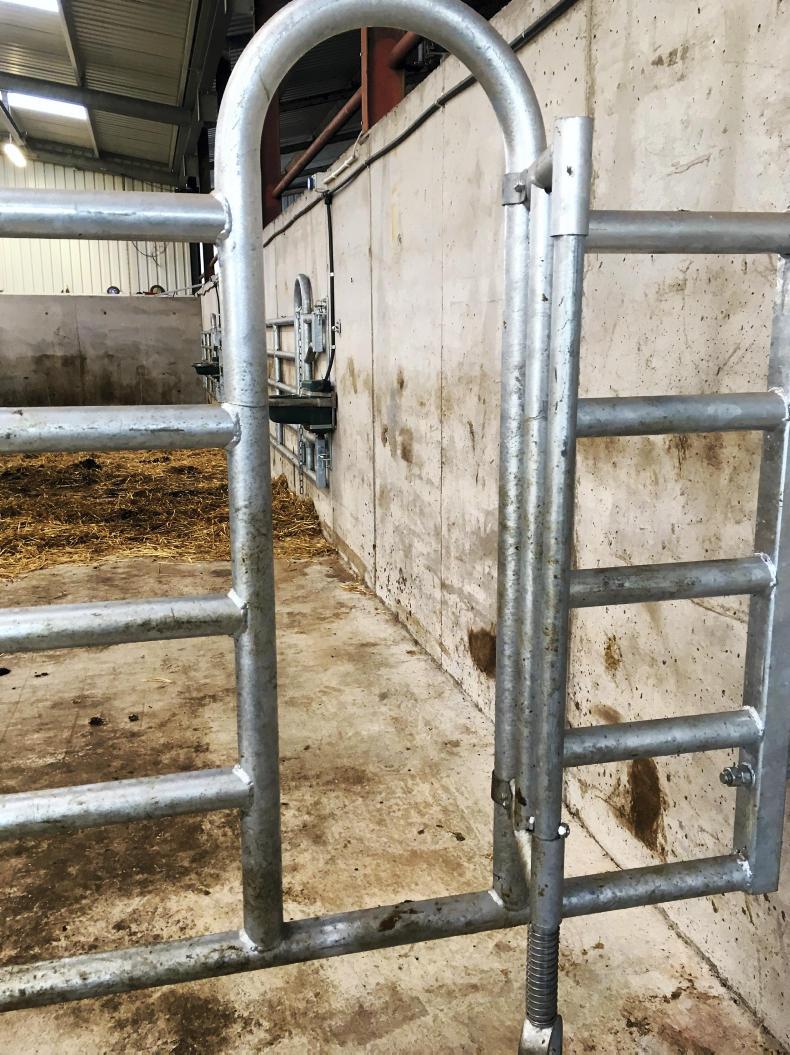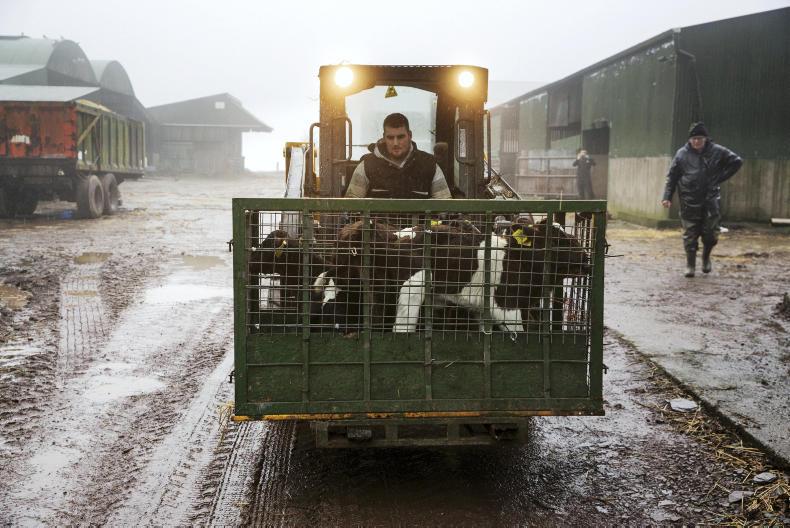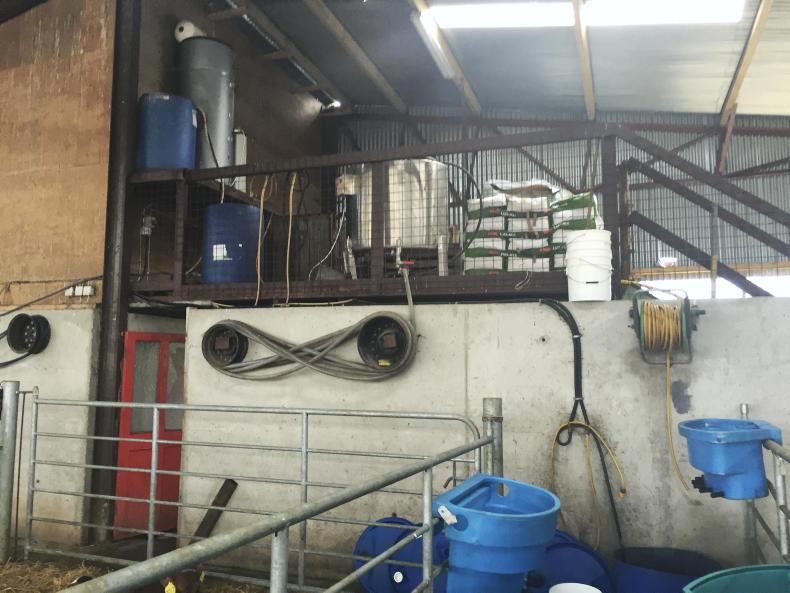One of the most obvious risks at calving is to get attacked by a cow. The protective maternal instincts of a cow kick in after calving and she is liable to attack a person if she feels the calf is threatened.
While the risk is greater in suckler cows, who get handled less than dairy cows, all cows are a risk and you can never take safety for granted at calving time.

Man pass in a gate will allow easy escape
The risk can be reduced by restraining the cow when handling the calf. The calf must be tagged and its navel dipped after calving. Do this when the cow is locked in a head barrier or move her to a different pen. Having a “man-pass” or a refuge in the calving pen will allow the operator a quick exit or a safe place in the event that the cow turns aggressive.
Leptospirosis
Leptospirosis is a widespread disease in suckler and dairy herds. It is a zoonotic disease so it can be spread to humans. In people, it causes flu-like symptoms and can also cause meningitis.
It is spread in urine splashes and uterine discharge.

Make sure you use protective clothing to prevent contact with leptospirosis diseaseMake sure you use protective clothing to prevent contact with leptospirosis disease.
Cows can be vaccinated for leptospirosis but even when cows are vaccinated precautions should be taken around calving time to prevent contact with urine and uterine discharge – or the fluids that come with the calf.
Burnout
One of the major safety risks at calving time is burnout. This is due to farmers working extremely long hours.
The result is exhaustion and it can lead to reduced immunity, causing sickness and ill health. Burnout and exhaustion are also linked to mental health problems and stress.
While there is no getting away from the fact that spring is a busy time, the risk of burnout can be minimised by making sure everyone working on the farm gets sufficient rest.
For those working on their own, it will mean prioritising jobs. List all the jobs that you do on the farm and then rank them in terms of priority. Protecting yourself should be the number one priority. If this means that some less important jobs are done less often or not done at all then so be it, eg liming cubicles twice a day. Feeding cows after 6pm will reduce the incidence of nighttime calvings to 10%.
Lifting and pulling
Protect your back. Pulling and lifting calves exerts very heavy weight on your back and can cause injury. Use a calving jack to assist with hard pulls. This has the power of five men.

Use machines or trolleys to move calves when possibleUse machines or trolleys to move calves when possible.
Try to avoid lifting calves if possible. Some farmers use a trolley or wheelbarrow with a low front that allows the calf to be slid up on to it. They use these to move young calves from one pen to the next.
Likewise, lifting buckets and bags of meal puts pressure on back and shoulder joints.

The loft at the back of a calf shed where the water heater, power washer, mixer and milk replacer is stored. The milk is then pumped to the drinkersThe loft at the back of a calf shed where the water heater, power washer, mixer and milk replacer is stored. The milk is then pumped to the drinkers.
Consider pumping milk or using trailed feeders rather than carrying buckets across yards.

One of the most obvious risks at calving is to get attacked by a cow. The protective maternal instincts of a cow kick in after calving and she is liable to attack a person if she feels the calf is threatened.
While the risk is greater in suckler cows, who get handled less than dairy cows, all cows are a risk and you can never take safety for granted at calving time.

Man pass in a gate will allow easy escapeThe risk can be reduced by restraining the cow when handling the calf. The calf must be tagged and its navel dipped after calving. Do this when the cow is locked in a head barrier or move her to a different pen. Having a “man-pass” or a refuge in the calving pen will allow the operator a quick exit or a safe place in the event that the cow turns aggressive.
Leptospirosis
Leptospirosis is a widespread disease in suckler and dairy herds. It is a zoonotic disease so it can be spread to humans. In people, it causes flu-like symptoms and can also cause meningitis.
It is spread in urine splashes and uterine discharge.

Make sure you use protective clothing to prevent contact with leptospirosis diseaseMake sure you use protective clothing to prevent contact with leptospirosis disease.
Cows can be vaccinated for leptospirosis but even when cows are vaccinated precautions should be taken around calving time to prevent contact with urine and uterine discharge – or the fluids that come with the calf.
Burnout
One of the major safety risks at calving time is burnout. This is due to farmers working extremely long hours.
The result is exhaustion and it can lead to reduced immunity, causing sickness and ill health. Burnout and exhaustion are also linked to mental health problems and stress.
While there is no getting away from the fact that spring is a busy time, the risk of burnout can be minimised by making sure everyone working on the farm gets sufficient rest.
For those working on their own, it will mean prioritising jobs. List all the jobs that you do on the farm and then rank them in terms of priority. Protecting yourself should be the number one priority. If this means that some less important jobs are done less often or not done at all then so be it, eg liming cubicles twice a day. Feeding cows after 6pm will reduce the incidence of nighttime calvings to 10%.
Lifting and pulling
Protect your back. Pulling and lifting calves exerts very heavy weight on your back and can cause injury. Use a calving jack to assist with hard pulls. This has the power of five men.

Use machines or trolleys to move calves when possibleUse machines or trolleys to move calves when possible.
Try to avoid lifting calves if possible. Some farmers use a trolley or wheelbarrow with a low front that allows the calf to be slid up on to it. They use these to move young calves from one pen to the next.
Likewise, lifting buckets and bags of meal puts pressure on back and shoulder joints.

The loft at the back of a calf shed where the water heater, power washer, mixer and milk replacer is stored. The milk is then pumped to the drinkersThe loft at the back of a calf shed where the water heater, power washer, mixer and milk replacer is stored. The milk is then pumped to the drinkers.
Consider pumping milk or using trailed feeders rather than carrying buckets across yards.











 This is a subscriber-only article
This is a subscriber-only article












SHARING OPTIONS: